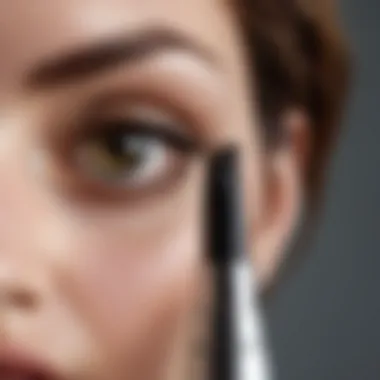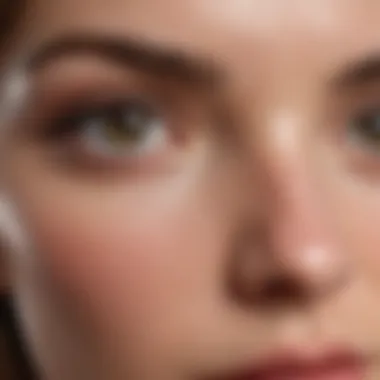Selecting the Best Eye Serum for Aging Skin


Intro
In the realm of skincare, the focus on aging around the eyes is notably significant. The delicate skin in that area exhibits the earliest signs of aging, including wrinkles, puffiness, and dark circles. As such, selecting the right eye serum to address these issues is essential for many women. This guide delves into the essential aspects of eye serums, exploring their formulations and how they can help in achieving a youthful appearance.
Understanding what an eye serum does and how it can enhance your skincare routine is crucial. These products typically contain concentrated active ingredients that target specific aging concerns. As consumers increasingly demand effective solutions, the beauty industry has responded with an array of options designed to cater to various skin types and preferences.
By gaining insights into the components of these serums, from hyaluronic acid to peptides, readers can make informed decisions. The article will examine current trends, step-by-step guides for usage, and detailed product reviews to provide a comprehensive resource for women seeking solutions for aging skin around the eyes.
Understanding Aging Skin Around the Eyes
Aging skin around the eyes represents a significant concern for many individuals. This area is particularly delicate and susceptible to visible change. Understanding the unique characteristics of aging skin around the eyes is essential for selecting the appropriate eye serum.
The skin near the eyes is thinner than the skin on other parts of the face. This makes it more prone to the effects of aging, such as lines, wrinkles, and discoloration. Factors like environmental stressors, skincare routine, and genetics can exacerbate these conditions. Consequently, it is crucial to target these issues with the right formulations that cater to the specific needs of this sensitive region.
An aging eye area not only affects appearance but can also impact emotional well-being. People often desire a youthful look to feel more confident in social and professional settings. Understanding the mechanisms of skin aging helps inform choices regarding the ingredients and properties needed in effective eye serums.
Anatomy of the Eye Area
The anatomy of the eye area is complex. It includes the lower and upper eyelids, orbital bones, and surrounding muscles. The skin here lacks oil glands, making it more vulnerable to dryness. Proper hydration is a fundamental consideration when selecting an eye serum.
The muscles around the eyes are continuously in motion, leading to increased stress on the skin. Over time, this contributes to various signs of aging. Maintaining skin integrity and improving elasticity are vital goals in any anti-aging regimen. To address these needs, a targeted approach using eye serums becomes paramount.
Common Signs of Aging
Fine Lines
Fine lines are often the first visible sign of aging in the eye area. They can develop due to a loss of collagen and elasticity in the skin. Fine lines usually appear around the corners of the eyes, commonly referred to as crow’s feet. Choosing a serum with ingredients like peptides can promote collagen production. This ingredient is beneficial because it helps to fill and smooth the fine lines, giving a fresher look.
Dark Circles
Dark circles are another prevalent concern. They can be caused by various factors, including genetics, lack of sleep, and vascular issues. The skin under the eyes has a transparent quality, making underlying blood vessels more noticeable. An effective serum can contain ingredients like caffeine that constrict blood vessels and reduce the appearance of dark coloration. This characteristic makes it a popular choice for those looking to brighten the area.
Puffiness
Puffiness in the eye area can result from fluid retention, allergies, or fatigue. Puffiness can detract from a youthful appearance. A serum targeting this issue often contains soothing ingredients such as chamomile or aloe vera. These components help in reducing inflammation and providing a calming effect, thus allowing for a smoother appearance.
Sagging
Sagging skin around the eyes develops due to the loss of firmness and volume. Factors such as aging, weight loss, and stress contribute to a lack of tightness. Selecting an eye serum with firming ingredients can counteract sagging skin. Ingredients like hyaluronic acid work to bind moisture and enhance skin elasticity, combating sagging effectively. This quality makes it a significant focus within the context of anti-aging.
Understanding these signs provides a clearer picture of what to look for in an effective eye serum. Considering the specific needs of the eye area allows for an informed selection process that aligns with personal skincare goals.
The Role of Eye Serums in Skincare
In the landscape of skincare, eye serums hold a distinguished position. As the skin around the eyes is notably delicate and prone to aging, eye serums are specifically formulated to address these unique concerns. Their concentrated formulation delivers active ingredients directly where they are needed most, aiming to reduce the visible signs of aging such as fine lines, puffiness, and dark circles. Understanding the role of eye serums provides valuable insight into how they can enhance an overall skincare regimen, especially for those focusing on anti-aging.
Functionality of Eye Serums


Hydration
Hydration is a fundamental aspect of maintaining youthful skin. Eye serums often boast high concentrations of hydrating agents like hyaluronic acid. This component is known for its ability to attract and retain moisture, making it a beneficial choice for combating dryness in the sensitive eye area.
A unique feature of hydration in eye serums is their lightweight texture, allowing for easy absorption without leaving a greasy residue. This characteristic ensures that the skin around the eyes remains plump and moisturized, which can help diminish the appearance of fine lines. However, those with oily skin may sometimes find hydrating serums overly rich, necessitating careful selection.
Repair
Repair functions focus on the restoration of skin integrity. Ingredients such as peptides and retinol are vital in this context. These compounds stimulate collagen production and cell turnover, which play critical roles in reducing wrinkles and enhancing skin firmness around the eyes.
The key characteristic of repair-focused eye serums is their ability to not only address existing signs of aging but also to work preventively against future damage. However, these serums can sometimes cause skin sensitivity, especially retinol-based ones, making it necessary for users to start with lower concentrations and gradually increase their usage.
Protection
Protection in eye serums involves guarding the skin against environmental stressors and free radicals. Ingredients like antioxidants, including vitamin C, are commonly included for their protective qualities. They neutralize harmful free radicals generated by sun exposure and pollution, ultimately maintaining skin health.
The core advantage of protection-enhanced eye serums is their dual function. They not only combat signs of aging but also protect against factors that hasten deterioration. Nonetheless, choosing serums with strong active ingredients requires careful patch testing, as some individuals may experience irritation depending on their skin sensitivity.
Comparison with Eye Creams
When choosing between eye serums and eye creams, several factors come into play. Eye creams are generally thicker and formulated for intense moisture. They may contain emollients that help lock in hydration but can sometimes feel heavy or greasy. In contrast, serums offer a lighter application with higher concentrations of active ingredients, which can penetrate deeper into the skin.
In summary, while eye creams serve as a dependable way to hydrate and nourish, eye serums excel in delivering potent actives targeted at specific issues like aging. Understanding these distinctions is crucial for investment in a skincare routine that addresses the unique needs of the eye area.
Key Ingredients to Look For
Choosing the right eye serum requires a good understanding of specific ingredients that effectively target signs of aging. This section will highlight the essential components one should prioritize when selecting an eye serum. Knowing these key ingredients not only helps in enhancing your skincare routine but also allows you to identify products that genuinely cater to your unique needs. Understanding what these ingredients can do makes it easier to make educated choices.
Peptides
Peptides are short chains of amino acids which act as building blocks for proteins like collagen and elastin. When included in eye serums, they play a significant role in skin repair and rejuvenation. These small molecules penetrate the skin to stimulate collagen production, which is crucial for maintaining skin elasticity. Regular use of peptides can diminish the appearance of fine lines and improve overall skin texture. Consider formulations that explicitly list peptide types to understand their specific benefits.
Retinol
Retinol, a derivative of Vitamin A, is renowned for its anti-aging properties. It works by accelerating cell turnover, promoting new skin growth and assisting in fading pigmentation. Eye serums with retinol can smooth out wrinkles and fine lines, making the skin around the eyes look firmer. However, it is worth noting that retinol can cause irritation for some, particularly for sensitive skin. Introduce this ingredient gradually to observe how your skin reacts, taking care to use it at night for optimal results.
Hyaluronic Acid
Hyaluronic Acid is a powerful humectant that can hold up to 1000 times its weight in moisture. This characteristic makes it an excellent choice for hydrating the delicate eye area. Serums containing hyaluronic acid plump the skin, reducing the appearance of puffiness and fine lines due to dehydration. Furthermore, when the skin is well-hydrated, it looks more youthful. Always look for serums with hyaluronic acid listed among their main ingredients to ensure optimum hydration.
Vitamin
Vitamin C is a potent antioxidant that protects skin cells from oxidative stress and free radical damage. It also helps to brighten dark circles, which is especially beneficial for combating tired-looking eyes. Moreover, Vitamin C promotes collagen synthesis, enhancing the skin's firmness. When searching for an eye serum, pick one that features stabilized Vitamin C for better efficacy. This will provide both protective and corrective benefits for aging skin.
Caffeine
Caffeine is not just for your morning cup of coffee; its properties extend to skincare as well. When included in eye serums, caffeine helps in reducing eye puffiness and improving circulation in the area. It can also work to constrict blood vessels, minimizing the appearance of dark circles. Look for eye serums where caffeine is highlighted in the ingredient list for a refreshing effect on tired eyes.
Antioxidants


Antioxidants play a critical role in the fight against skin aging by neutralizing free radicals. Various antioxidants, such as green tea extract, resveratrol, and coenzyme Q10, hold significant benefits for skin health. They can boost skin repair mechanisms, enhance brightness, and improve overall skin resilience. Incorporating eye serums with antioxidants will not only help in addressing existing signs of aging but also in preventing future damage.
Understanding these key ingredients and their specific benefits is crucial in selecting the most effective eye serum for aging. It is essential to examine product labels carefully and prioritize those that offer a combination of these powerful components.
Evaluating these ingredients while choosing an eye serum will empower you to make informed decisions that align with your skincare goals.
Evaluating Efficacy of Eye Serums
When selecting an eye serum, understanding its efficacy is crucial. Evaluating how well a product works not only informs purchasing decisions but also affects long-term skincare routines. The effectiveness of eye serums can vary significantly based on formulation, application methods, and individual response. This section will explore the methods used to assess the efficacy of eye serums, emphasizing the importance of clinical studies and the value of user experiences.
Clinical Studies and Testing
Clinical studies play a vital role in determining the effectiveness of eye serums. Scientific testing often involves controlled environments where participants use a serum under specific conditions. These studies measure various parameters such as reductions in puffiness, improvement in fine lines, and general skin texture enhancements.
- Objective Measurements: Instruments are sometimes used to quantify results. Skin hydration levels can be accurately measured, as can the visibility of dark circles or sagging skin.
- Duration of Studies: Typical trials may last from several weeks to months. Long-term studies can provide insights into sustained benefits or adverse effects.
- Diverse Demographics: Including a varied group of participants helps to ensure that the findings are applicable across different age groups and skin types.
It is essential for consumers to seek products that are backed by robust clinical testing. Look for serums with published results in reputable dermatological journals or industry standards.
User Experience and Testimonials
User experience offers compelling insights into the true performance of eye serums. Individual accounts can provide context that clinical studies might not capture. Relying on personal testimonials allows potential users to gauge the subjective effectiveness of a product.
- Real-World Applications: Users report on their experiences with application, texture, and absorption. This information helps others understand if a product fits into their daily routine.
- Before and After Comparisons: Many consumers share visual testimonials that showcase the visible effects over time, granting prospective buyers a realistic expectation.
- Adaptability: Comments on how serums work with different skin types are invaluable. They highlight whether a product causes irritation or if it is suitable for sensitive skin.
Users often emphasize that products that deliver visible changes in skin appearance bring more satisfaction, making personal feedback essential in evaluating a serum's efficacy.
Recommendations for the Best Eye Serums
Selecting the right eye serum involves understanding various factors that cater to individual skincare needs. Recommendations for the best eye serums focus on identifying effective products that can yield visible results, especially when dealing with aging skin. Different formulations come with advantages that can meet specific skin concerns, from hydration and fine line reduction to the management of dark circles and puffiness. Understanding the characteristics of such products allows users to make informed choices, enhancing their overall skincare routine.
High-End Options
High-end eye serums typically offer concentrated active ingredients and advanced formulations. These products tend to incorporate cutting-edge technologies in skincare, maximizing their effectiveness. For instance, brands like La Prairie and SK-II are known for luxury products with potent anti-aging elements. When considering high-end eye serums, some important factors to keep in mind include:
- Ingredient potency: Many high-end serums contain higher concentrations of beneficial compounds such as peptides and retinol, which are essential for skin repair and rejuvenation.
- Texture and absorption: These formulations are often designed for better absorption, allowing the active ingredients to penetrate deeply into the skin.
- Packaging: Luxury brands may employ innovative packaging that protects the integrity of the ingredients.
While luxury options may represent a larger financial investment, they often come with the promise of visible results, making them tempting for serious skincare enthusiasts.
Affordable Choices
Not everyone can allocate a significant budget for skincare, and fortunately, there are effective eye serums available at a more accessible price point. Brands like The Ordinary and Neutrogena provide formulations that deliver results without excessive costs. When examining affordable eye serums, consider the following:
- Performance vs. Price: Many affordable products contain effective ingredients without the luxury price tag. Check for formulations with hyaluronic acid, vitamin C, or caffeine, as these are known to contribute to skin hydration and brightening.
- User Reviews: Reading user testimonials can help gauge the efficacy of more budget-friendly options. A popular product that receives positive feedback might be a great alternative to its high-end counterparts.
- Availability: Affordable eye serums are often available at local drugstores, making it easy to purchase and replenish.
Natural and Organic Selections
With the increasing demand for clean beauty, many users are exploring natural and organic eye serums. Brands like Burt's Bees and Tata Harper focus on using natural ingredients, avoiding synthetic additives that may harm sensitive skin types. When delving into this category:


- Ingredient Transparency: Natural products often feature simple, recognizable components. This transparency can be reassuring for consumers wary of harsh chemicals.
- Sustainability: Many organic brands prioritize environmentally friendly practices, appealing to those who value sustainability in their products.
- Skin Compatibility: Natural formulations are usually gentler on the skin, making them suitable for users with sensitivities or specific allergies.
A well-suited eye serum can make a considerable difference in your skincare routine, particularly in addressing aging concerns around the eyes. Evaluating each option based on ingredients, delivery systems, and cost allows for tailored selections to meet your needs.
Application Techniques for Eye Serums
Applying eye serums correctly can significantly influence their effectiveness. Many users may invest in the best formulations, yet fail to see results due to improper application techniques. Understanding how to apply eye serums properly ensures that the active ingredients penetrate the skin effectively and deliver their promised benefits. This section will highlight the nuances in application techniques, emphasizing key points such as gentle handling of the eye area, optimal product quantity, and the significance of consistency in usage.
How to Apply Effectively
When it comes to applying eye serums, gentleness matters. The skin around the eyes is delicate, and using too much pressure can cause more harm than good. Here are some effective steps to ensure proper application:
- Cleanse Your Skin: Start with a clean face. Wash away any makeup, dirt, or oils that may interfere with serum absorption.
- Use a Small Amount: A pea-sized amount is typically sufficient. Applying too much can lead to product buildup and irritation.
- Dot Technique: Use your ring finger, which exerts the least pressure. Dot the serum along the orbital bone, avoiding direct contact with the eyes.
- Pat, Don't Rub: Gently tap the serum into the skin. This method encourages absorption without overstretching the skin.
- Inward to Outward Motion: Apply from the inner corner of the eye outward. This technique helps in draining puffiness and keeps the skin from sagging.
- Avoid Eyelids: Focus primarily on the under-eye area and the outer corners. Most eye serums are not designed for the eyelids and can cause irritation if applied there.
By following these steps, users can maximize the benefits of their chosen eye serum, ensuring the skin around their eyes receives the care it needs without unnecessary irritation.
Timing and Frequency
The timing and frequency of application are also crucial in reaping the benefits of eye serums. Regular use not only maintains skin hydration but also promotes long-term results. Here are several important considerations:
- Morning and Night Routine: Applying eye serum both in the morning and evening can yield the best results. In the morning, it can help reduce puffiness and prepare the skin for makeup. In the evening, it aids in skin recovery overnight.
- Consistency is Key: Much like other skincare products, consistency in application is essential. Skipping days may slow down visible improvement or diminish the effectiveness of the ingredients.
- Layering Products: When combining eye serums with other products such as moisturizers or sunblock, it is advisable to apply the serum before these products. This layering allows the eye serum's active ingredients to work effectively without being obstructed.
As a rule of thumb, users should always follow the specific instructions provided by the manufacturer. This ensures that the eye serum delivers optimal benefits as intended.
Troubleshooting Common Issues
Understanding how to effectively troubleshoot common issues is essential when selecting an eye serum for aging. Many users encounter problems that may hinder the effectiveness of their chosen product. Recognizing these issues and knowing how to address them ensures that one gets the desired results from their skincare routine.
Allergic Reactions
Allergic reactions are a significant concern for many individuals using eye serums. These products often contain potent active ingredients, which can cause irritation or allergic responses in sensitive skin. Symptoms might include redness, swelling, or a burning sensation upon application.
- Identify Allergens: It is crucial to read the ingredient list carefully. Look for known allergens that might trigger a response. Common culprits in eye serums can include fragrances, specific preservatives, or even botanical extracts.
- Patch Test: Prior to using a new product, conduct a patch test on a small area of skin, like the forearm. This can help detect allergens without exposing the sensitive eye area to potential irritants.
- Consult a Specialist: If there is any uncertainty regarding ingredients and their effects, consulting a dermatologist can provide personalized guidance. They can recommend suitable alternatives and help discern between allergic reactions and simple skin irritation.
"Regular monitoring and attention can prevent unnecessary discomfort when introducing new products into your skincare routine."
Incorrect Product Use
Another prevalent issue arises from incorrect product use. Even the best eye serum may fail to deliver results if it is applied improperly. Here are some considerations in ensuring that one gets the most from their serum:
- Application Technique: The method of application is crucial. Ideally, the serum should be applied using the ring finger, as this digit exerts the lightest pressure. Gently tapping the serum into the skin can enhance absorption and minimize the risk of damage to the delicate area.
- Timing: Timing can also play a role in the effectiveness of eye serums. Many formulations work best when applied after cleansing and before moisturizing. Applying at night can maximize benefits during the skin's natural repair cycle.
- Compatibility with Other Products: Check how the eye serum interacts with other products in the skincare routine. Layering incompatible ingredients can diminish the effectiveness of serums. Ensure that the formulation complements other products, avoiding conflicts with potent ingredients such as retinol or strong acids.
Epilogue: Making Informed Choices
The journey of selecting an eye serum tailored for aging skin transcends mere consumer choice. It embodies a serious commitment to understanding one’s own skin needs and the products that can genuinely address them. As we have explored various elements in this article, from the anatomy of the eye area to application techniques, the importance of making informed decisions cannot be overstated.
Choosing the optimal eye serum requires careful consideration of several factors. First, understanding the common signs of aging will aid in determining what specific issues one needs to address. Whether it be fine lines, dark circles, or sagging skin, pinpointing the right concerns allows for targeted treatment options to be explored.
Moreover, knowledge of key ingredients plays a crucial role in this decision-making process. Peptides, retinol, and hyaluronic acid are vital components that should be considered for their proven efficacy in skin repair and renewal. Researching the ingredients further encourages an evaluation of clinical studies and user testimonials. These resources can provide valuable insight into how a product performs in real life versus its theoretical benefits.
Furthermore, it is important to reflect on personal preferences and needs. Some individuals may prioritize natural ingredients, while others may seek high-end formulations for their advanced technologies. Regardless of the direction taken, aligning product choices with one’s values and skin type is essential.
"An informed choice is not just about selecting a product; it is about understanding the interplay between the ingredients, efficacy, and your personal skin goals."
As we elevate our skincare routines, particularly around such a delicate area as the eyes, thoughtful curation of products is critical. This careful selection process will ultimately yield the best results in combating the visible signs of aging.



